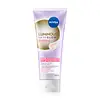What's inside
What's inside
 Key Ingredients
Key Ingredients

No key ingredients
 Benefits
Benefits

 Concerns
Concerns

 Ingredients Side-by-side
Ingredients Side-by-side

Water
Skin ConditioningPropylene Glycol
HumectantPalmitic Acid
EmollientStearic Acid
CleansingGlycerin
HumectantLauric Acid
CleansingPEG-150
HumectantPEG-8
HumectantGlycyrrhiza Glabra Root Extract
BleachingFucus Vesiculosus Extract
EmollientPanax Ginseng Root Extract
EmollientAluminum Chlorohydrate
AstringentCarnitine
CleansingGlyceryl Glucoside
HumectantMalpighia Glabra Fruit Juice
Skin ConditioningCera Alba
EmollientSodium Methyl Cocoyl Taurate
CleansingLactic Acid
BufferingArachidic Acid
CleansingOleic Acid
EmollientCaprylic/Capric Triglyceride
MaskingTrideceth-9
EmulsifyingCitric Acid
BufferingGlucose
HumectantPEG-40 Hydrogenated Castor Oil
EmulsifyingBisabolol
MaskingCaramel
Cosmetic ColorantTrisodium EDTA
Sodium Benzoate
MaskingWater, Propylene Glycol, Palmitic Acid, Stearic Acid, Glycerin, Lauric Acid, PEG-150, PEG-8, Glycyrrhiza Glabra Root Extract, Fucus Vesiculosus Extract, Panax Ginseng Root Extract, Aluminum Chlorohydrate, Carnitine, Glyceryl Glucoside, Malpighia Glabra Fruit Juice, Cera Alba, Sodium Methyl Cocoyl Taurate, Lactic Acid, Arachidic Acid, Oleic Acid, Caprylic/Capric Triglyceride, Trideceth-9, Citric Acid, Glucose, PEG-40 Hydrogenated Castor Oil, Bisabolol, Caramel, Trisodium EDTA, Sodium Benzoate
Sodium Lauroyl Isethionate
CleansingStearic Acid
CleansingSodium Palmitate
CleansingWater
Skin ConditioningLauric Acid
CleansingSodium Isethionate
CleansingSodium Stearate
CleansingCocamidopropyl Betaine
CleansingSodium Palm Kernelate
CleansingGlycerin
HumectantSodium Chloride
MaskingZinc Oxide
Cosmetic ColorantTetrasodium EDTA
Tetrasodium Etidronate
Emulsion StabilisingAlumina
AbrasiveCI 77891
Cosmetic Colorant
 Reviews
Reviews

Ingredients Explained
These ingredients are found in both products.
Ingredients higher up in an ingredient list are typically present in a larger amount.
Glycerin is already naturally found in your skin. It helps moisturize and protect your skin.
A study from 2016 found glycerin to be more effective as a humectant than AHAs and hyaluronic acid.
As a humectant, it helps the skin stay hydrated by pulling moisture to your skin. The low molecular weight of glycerin allows it to pull moisture into the deeper layers of your skin.
Hydrated skin improves your skin barrier; Your skin barrier helps protect against irritants and bacteria.
Glycerin has also been found to have antimicrobial and antiviral properties. Due to these properties, glycerin is often used in wound and burn treatments.
In cosmetics, glycerin is usually derived from plants such as soybean or palm. However, it can also be sourced from animals, such as tallow or animal fat.
This ingredient is organic, colorless, odorless, and non-toxic.
Glycerin is the name for this ingredient in American English. British English uses Glycerol/Glycerine.
Learn more about GlycerinLauric Acid is a fatty acid or lipid. About half of fatty acids in coconut oil is lauric acid.
This ingredient helps hydrate and sooth skin. As a humectant, it helps trap moisture. It also aids in cleaning and enhancing the texture of products.
Lauric acid may not be Malassezia folliculitis, or fungal acne, safe.
Learn more about Lauric AcidStearic Acid is a fatty acid. It is an emollient, emulsifier, and texture enhancer.
As an emollient, stearic acid helps soften skin. It aids the skin's protective barrier by preventing water loss. It also provides a gentle cleansing effect without stripping away natural oils.
Stearic acid may also be used to enhance the texture of products. It can add volume and stabilize ingredients such as water and oil. This can help water and oil ingredients from separating.
Sources of stearic acid include animal or vegetable fats/oils such as coconut or shea. It can be naturally found in butter, cocoa butter, shea butter, vegetable fats, and animal tallow.
This ingredient may not be Malassezia folliculitis, or fungal-acne safe.
Learn more about Stearic AcidWater. It's the most common cosmetic ingredient of all. You'll usually see it at the top of ingredient lists, meaning that it makes up the largest part of the product.
So why is it so popular? Water most often acts as a solvent - this means that it helps dissolve other ingredients into the formulation.
You'll also recognize water as that liquid we all need to stay alive. If you see this, drink a glass of water. Stay hydrated!
Learn more about Water